Practicing the Bridges in Mathematics Grade 4 Student Book Answer Key Unit 7 Module 2 will help students analyze their level of preparation.
Bridges in Mathematics Grade 4 Student Book Answer Key Unit 7 Module 2
Bridges in Mathematics Grade 4 Student Book Unit 7 Module 2 Session 1 Answer Key
Decimal Fractions & Numbers
Question 1.
Fill in the missing decimals and fractions on the number line.

Answer:
Question 2.
When numbers share a place on the number line, that means they are equivalent. For each number, circle the other numbers that are equivalent.
a. 0.7
7 0.70 70 \(\frac{7}{10}\) \(\frac{70}{100}\) 0.07 \(\frac{7}{100}\)
Answer:
0.70, \(\frac{7}{10}\), and \(\frac{70}{100}\).
Explanation:
The equivalent numbers to 0.7 is 0.70, \(\frac{7}{10}\), and \(\frac{70}{100}\).
b. \(\frac{9}{10}\)
0.09 \(\frac{9}{100}\) 0.9 0.90 \(\frac{90}{100}\) 9 90
Answer:
0.9, 0.90, and \(\frac{90}{100}\).
Explanation:
The equivalent numbers to \(\frac{9}{10}\) is 0.9, 0.90, and \(\frac{90}{100}\).
c. \(\frac{40}{100}\)
0.4 \(\frac{4}{100}\) 40 4 \(\frac{4}{10}\) 0.04 0.40
Answer:
0.4, \(\frac{4}{10}\), and 0.40.
Explanation:
The equivalent numbers to \(\frac{40}{100}\) is 0.4, \(\frac{4}{10}\), and 0.40.
Question 3.
Shade in the grid to show each number. Write two decimal numbers to represent each value.
a.
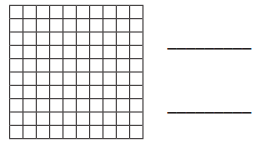
Answer:
The two decimal numbers will be 0.8 and 0.80.
Explanation:
Here, we have shaded 8 blocks out of 10 which is \(\frac{8}{10}\) = 0.8 and the other decimal number will be \(\frac{80}{100}\) = 0.80.

b.
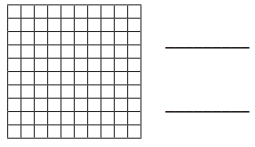
Answer:
The two decimal numbers will be 0.3 and 0.30.
Explanation:
Here, we have shaded 3 blocks out of 10 which is \(\frac{3}{10}\) = 0.3 and the other decimal number will be \(\frac{30}{100}\) = 0.30.

Bridges in Mathematics Grade 4 Student Book Unit 7 Module 2 Session 2 & 3 Answer Key
Scoot the Marker Instructions
- Fasten your decimal strip to a table, the floor, or another smooth and flat surface.
- Set your game marker to one side of your decimal strip, as shown.

- Flick your marker, and read the distance it traveled.
- If the marker lands too far away from the decimal strip to read the distance accurately, use your pencil to help.
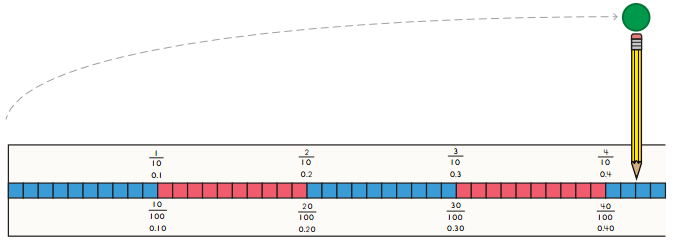
- Record the distance on the record sheet in fractions (for fractions game) or decimals (for numbers game), as shown below.
- Repeat until you and your partner have each taken 5 turns.
- Write an inequality statement on your record sheet to show which range each distance falls into, as shown below.
- Figure out how many points you got for each turn. Add them to find your total score.
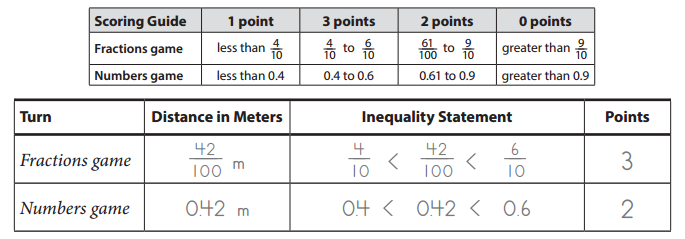
Bridges in Mathematics Grade 4 Student Book Unit 7 Module 2 Session 2 Answer Key
Scoot the Marker Record Sheet Decimal Fractions Game
See game instructions above.
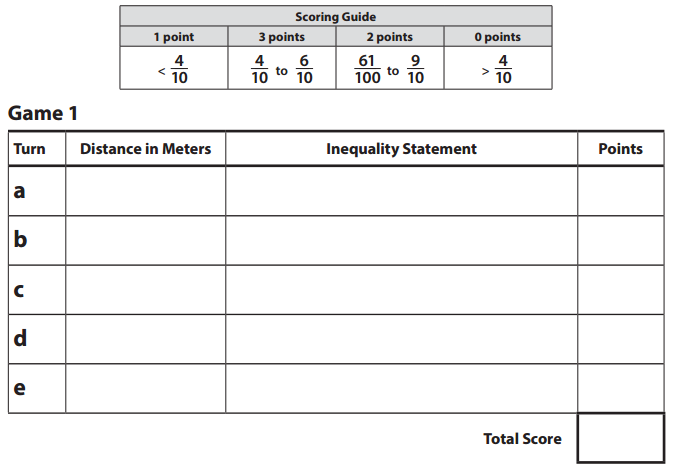
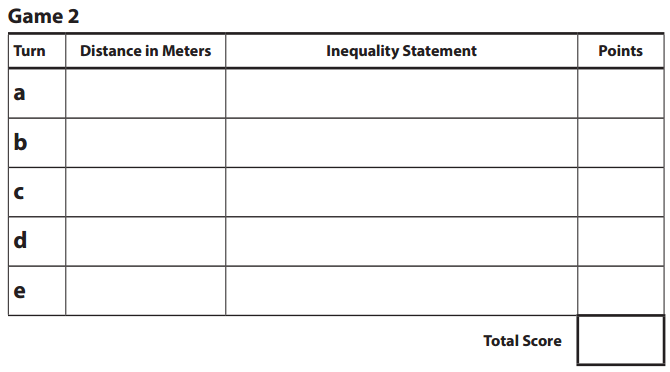
Answer:
Here, we have recorded the distance on the record sheet in fractions in game 1 and decimals in game 2 and written an inequality statement on the record sheet to show which range each distance falls into
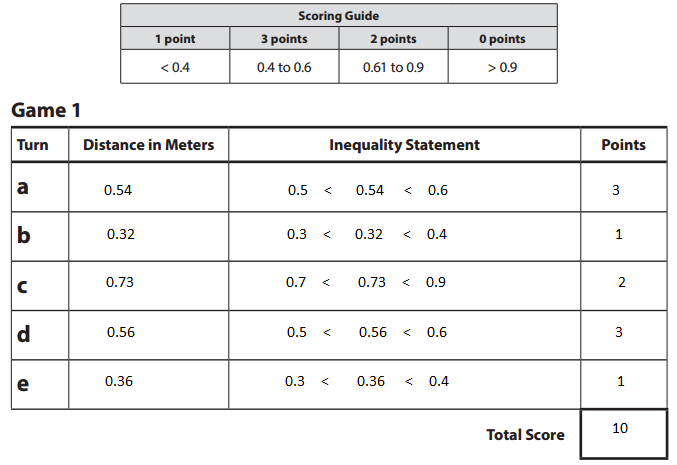
Decimal Fractions on Line & Grid
Question 1.
Label each marked point on the decimal strip with a fraction. Use tenths when you can, and hundredths when you must.

Answer:
Here, we have labeled each marked point on the decimal strip with a fraction.

Question 2.
Write each number you labeled on the number line above here. Then shade in the grid to show each value and write a fraction to represent it.
a.
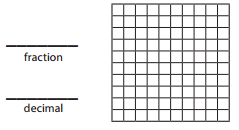
Answer:
Fraction = \(\frac{7}{100}\),
Decimal = 0.07.
Explanation:
Here, we have shaded 7 blocks out of 100 which is \(\frac{7}{100}\) = 0.07.
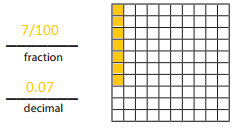
b.

Answer:
Fraction = \(\frac{4}{10}\),
Decimal = 0.4.
Explanation:
Here, we have shaded 4 blocks out of 10 which is \(\frac{4}{10}\) = 0.4.
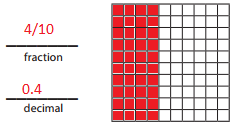
c.

Answer:
Fraction = \(\frac{53}{100}\),
Decimal = 0.53.
Explanation:
Here, we have shaded 53 blocks out of 100 which is \(\frac{53}{100}\) = 0.53.
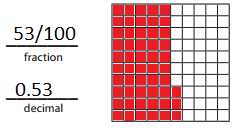
d.

Answer:
Fraction = \(\frac{9}{10}\),
Decimal = 0.9
Explanation:
Here, we have shaded 9 blocks out of 10 which is \(\frac{9}{10}\) = 0.9.

Question 3.
Write fractions and decimals to show how much of each grid is shaded.
a.
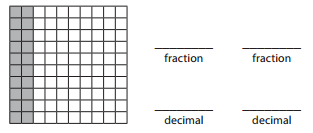
Answer:
Fraction = \(\frac{2}{10}\),
Decimal = 0.2.
Explanation:
Here, we have shaded 2 blocks out of 10 which is \(\frac{2}{10}\) = 0.2.

b.
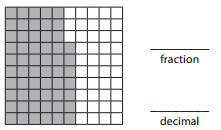
Answer:
Fraction = \(\frac{57}{100}\),
Decimal = 0.57.
Explanation:
Here, we have shaded 57 blocks out of 100 which is \(\frac{57}{100}\) = 0.57.

Question 4.
Why can you write two different decimal fractions and decimal numbers for grid a, and only one for each for grid b in problem 3 above?
Answer:
Here, \(\frac{57}{100}\) cannot be described using a whole number of tenths and if there is something other than zero in the hundredths place. And if there is something other than 0 in the hundredths place and we need to show it.
Bridges in Mathematics Grade 4 Student Book Unit 7 Module 2 Session 3 Answer Key
Scoot the Marker Record Sheet Decimal Numbers Game
See game instructions

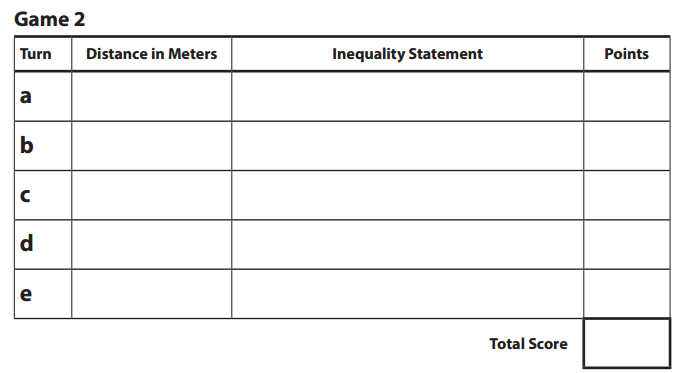
Answer:
Here, we have recorded the distance on the record sheet in decimals and written an inequality statement on the record sheet to show which range each distance falls into
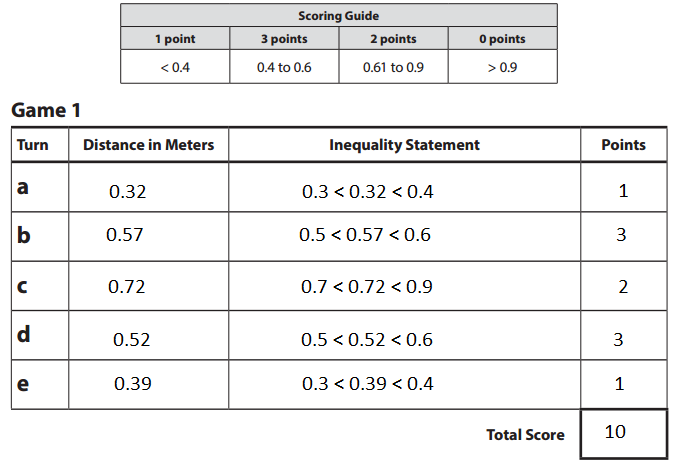

Writing & Comparing Decimal Numbers
Question 1.
Use the grid below to answer the questions.
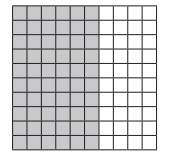
a. How many tenths are filled in?
Answer:
6 tenths.
Explanation:
There are 6 tenths filled in the box.
b. How many hundredths are filled in?
Answer:
60 hundredths.
Explanation:
There are 60 hundredths filled in the box.
c. Fill in the blanks to write two fractions that represent this amount.

Answer:
The two fractions are

d. Fill in the blanks to show two decimal numbers that represent this amount.
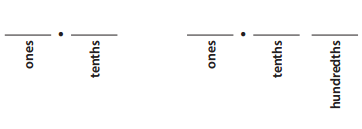
Answer:
0.6 and 0.60.
Explanation:
The two decimal numbers that represent this amount are

Question 2.
Fill in the blanks to show one or two decimal numbers that represent each fraction or mixed number.
a. \(\frac{3}{10}\)

Answer:
0.3 and 0.30
Explanation:
The two decimal numbers that represent this amount are
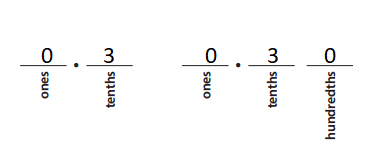
b. 2\(\frac{23}{100}\)

Answer:
2.23.
Explanation:
The decimal number that represent this amount are
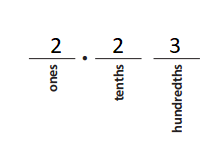
c. 4\(\frac{1}{10}\)

Answer:
4.1 and 4.10
Explanation:
The two decimal numbers that represent this amount are
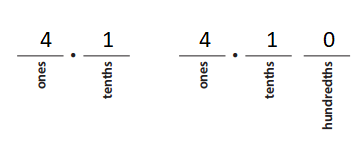
d. 5\(\frac{6}{100}\)
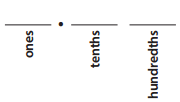
Answer:
5.06.
Explanation:
The decimal number that represent this amount are

Question 3.
a. Locate each decimal number on the number line.
0.06
0.6

Answer:

b. Complete the two inequalities to compare the two decimal numbers above.
_____________ > _____________
_____________ < _____________
Answer:
0.6 > 0.06
0.06 < 0.6.
Explanation:
The comparison of two decimal numbers above is
0.6 is greater than 0.06 and 0.06 is lesser than 0.6.
Bridges in Mathematics Grade 4 Student Book Unit 7 Module 2 Session 4 Answer Key
Adding Decimal Fractions
Question 1.

Will the sum be…
![]() less than \(\frac{1}{2}\)
less than \(\frac{1}{2}\)
![]() equal to \(\frac{1}{2}\)
equal to \(\frac{1}{2}\)
![]() greater than \(\frac{1}{2}\)
greater than \(\frac{1}{2}\)

Answer:
\(\frac{2}{5}\) is less than \(\frac{1}{2}\).
Explanation:
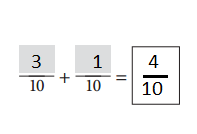
The addition of two decimal fractions \(\frac{3}{10}\)+\(\frac{1}{10}\) is
= \(\frac{3+1}{10}\)
= \(\frac{4}{10}\)
= \(\frac{2}{5}\)
which is less than \(\frac{1}{2}\).

Question 2.

Will the sum be…
![]() less than \(\frac{1}{2}\)
less than \(\frac{1}{2}\)
![]() equal to \(\frac{1}{2}\)
equal to \(\frac{1}{2}\)
![]() greater than \(\frac{1}{2}\)
greater than \(\frac{1}{2}\)

Answer:
\(\frac{1}{2}\) = \(\frac{1}{2}\).
Explanation:
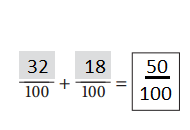
The addition of two decimal fractions \(\frac{32}{100}\)+\(\frac{18}{100}\) is
= \(\frac{32+18}{100}\)
= \(\frac{50}{100}\)
= \(\frac{1}{2}\)
which is equal to \(\frac{1}{2}\).

Question 3.
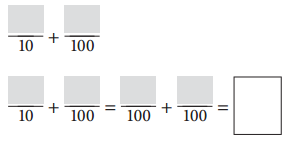
Will the sum be…
![]() less than \(\frac{1}{2}\)
less than \(\frac{1}{2}\)
![]() equal to \(\frac{1}{2}\)
equal to \(\frac{1}{2}\)
![]() greater than \(\frac{1}{2}\)
greater than \(\frac{1}{2}\)

Answer:
\(\frac{9}{10}\) > \(\frac{1}{2}\)
Explanation:
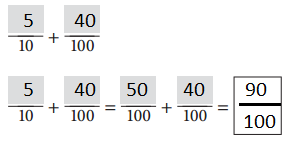
The addition of two decimal fractions \(\frac{5}{10}\)+\(\frac{40}{100}\) is
= \(\frac{50+40}{100}\)
= \(\frac{90}{100}\)
= \(\frac{9}{10}\)
which is greater than \(\frac{1}{2}\)

Question 4.
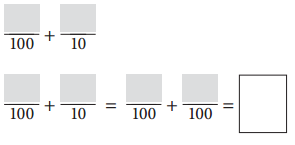
Will the sum be…
![]() less than \(\frac{1}{2}\)
less than \(\frac{1}{2}\)
![]() equal to \(\frac{1}{2}\)
equal to \(\frac{1}{2}\)
![]() greater than \(\frac{1}{2}\)
greater than \(\frac{1}{2}\)

Answer:
1 is greater than \(\frac{1}{2}\).
Explanation:

The addition of two decimal fractions \(\frac{30}{100}\)+\(\frac{7}{10}\) is
= \(\frac{30+70}{100}\)
= \(\frac{100}{100}\)
= 1
which is greater than \(\frac{1}{2}\).

Snail & Caterpillar Race to \(\frac{300}{100}\) Instructions
Each pair of players needs:
- a Snail & Caterpillar Race to \(\frac{300}{100}\) Record Sheet for each player
- 3 dice, one each numbered 0-5, 1-6, and 4-9
- 4 colored pencils of different colors (each player will use 2 colors)
1. Players roll the 4-9 die to see who will be Player 1. Player 1 gets to choose whether to play for the snail or the caterpillar. Players each circle the creature they’re playing for.
2. Players take turns rolling and recording fractions. On each turn, the player:
- Rolls all 3 dice, then chooses one of the numbers rolled to take in tenths and fills that number in on the record sheet.
- Decides how to arrange the other two numbers rolled to make a double-digit number to take in hundredths, and records that number on the record sheet.

- Shades in the tenths on the decimal strip using one color.
- Shades in the hundredths on the decimal strip using another color.
- Rewrites the tenths as hundredths, then adds the two fractions and records the sum.

3. Players play 3 rounds, each player rolling the dice and recording fractions once per round.
Players record their partner’s turns on the other decimal strip, but do not record their fractions. For example, if you are playing for the snail, record your partner’s turn on the caterpillar’s strip on your record sheet.
4. At the end of the game, each player finds their total by recording and adding their three scores at the bottom of the record sheet. Then players compare their totals to \(\frac{300}{100}\) and record the comparisons.
The player with the total closest to, but not greater than, \(\frac{300}{100}\) wins.

Consider strategies for winning. If you roll large numbers in the first round, what will you try to do next round? What would be the best amount to have in all 3 rounds to make your total come closest to \(\frac{300}{100}\)?
Snail & Caterpillar Race to \(\frac{300}{100}\) Record Sheet 1
I am racing for the Snail Caterpillar
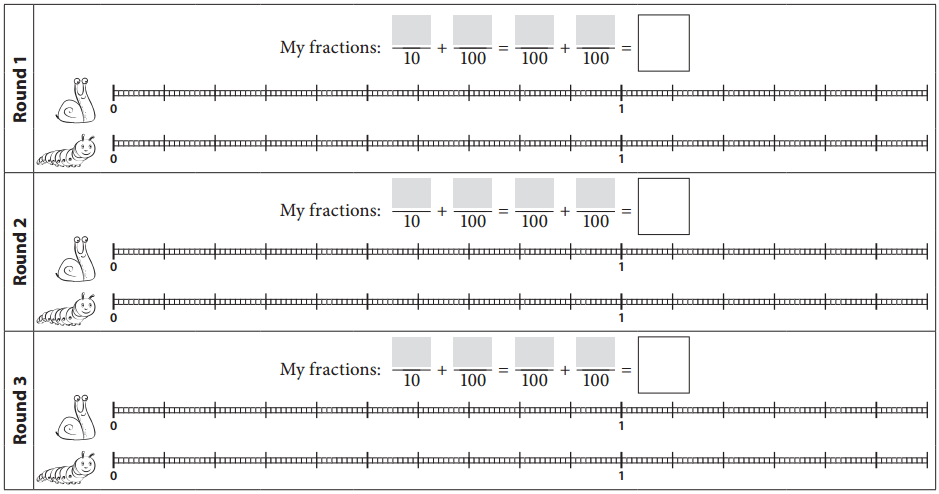

Compare your total to \(\frac{300}{100}\) Do the same for your partner’s total. Circle the total that is closest to, but not greater than, \(\frac{300}{100}\).

Answer:
My partner score is less than \(\frac{300}{100}\).
Explanation:
Here, we recorded for snail and the total of the three rounds is \(\frac{110}{100}\)+\(\frac{114}{100}\)+\(\frac{104}{100}\) = \(\frac{358}{100}\)



By comparing my partner score is less than \(\frac{300}{100}\).
Snail & Caterpillar Race to \(\frac{300}{100}\) Record Sheet 2
I am racing for the Snail Caterpillar


Compare your total to \(\frac{300}{100}\) Do the same for your partner’s total. Circle the total that is closest to, but not greater than, \(\frac{300}{100}\).

Answer:
My score is less than \(\frac{300}{100}\).
Explanation:
Here, we recorded for snail and the total of the three rounds is \(\frac{87}{100}\)+\(\frac{54}{100}\)+\(\frac{126}{100}\) = \(\frac{267}{100}\)
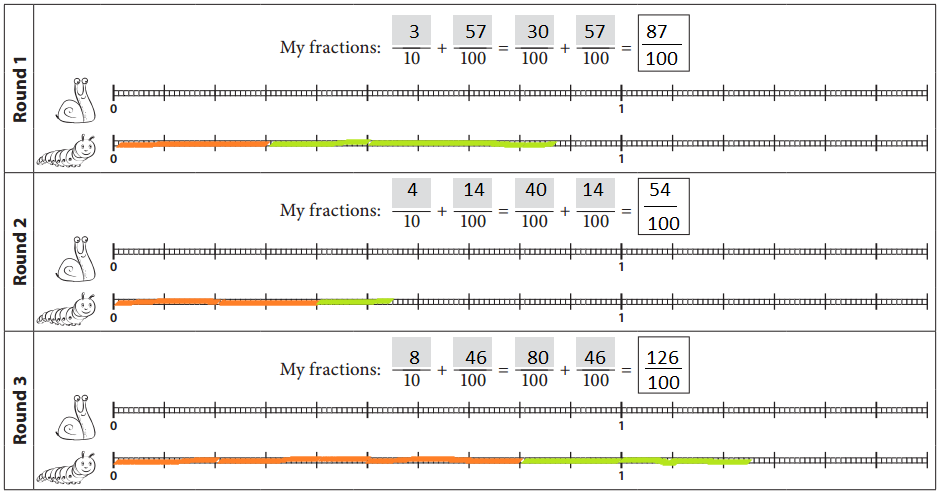


By comparing my score is less than \(\frac{300}{100}\).
Decimal Review
Question 1.
Label each point on the number line, using decimals below the line and fractions above it.

Answer:
Here, we have labelled each point on the number line, using decimals below the line and fractions above it.

Question 2.
Find each sum. Show your work.
\(\frac{34}{100}\) + \(\frac{4}{10}\) = ________________
\(\frac{3}{10}\) + \(\frac{6}{100}\) = ________________
\(\frac{7}{10}\) + \(\frac{13}{100}\) = ________________
Answer:
\(\frac{34}{100}\) + \(\frac{4}{10}\) = \(\frac{74}{100}\).
\(\frac{3}{10}\) + \(\frac{6}{100}\) = \(\frac{90}{100}\).
\(\frac{7}{10}\) + \(\frac{13}{100}\) = \(\frac{83}{100}\).
Explanation:
The sum of \(\frac{34}{100}\) + \(\frac{4}{10}\) is
= \(\frac{34+40}{100}\)
= \(\frac{74}{100}\)
= 0.74.
The sum of \(\frac{3}{10}\) + \(\frac{6}{100}\) is
= \(\frac{30+60}{100}\)
= \(\frac{90}{100}\).
= 0.9.
The sum of \(\frac{7}{10}\) + \(\frac{13}{100}\) is
= \(\frac{70+13}{100}\)
= \(\frac{83}{100}\).
= 0.83.
Question 3.
Write each sum above as a decimal number.
a _____________
b _____________
c ______________
Answer:
a. 0.74
b. 0.36
c. 0.83.
Explanation:
The sum of \(\frac{34}{100}\) + \(\frac{4}{10}\) in decimal number is
= 0.34+0.4
= 0.74.
The sum of \(\frac{3}{10}\) + \(\frac{6}{100}\) in decimal number is
= 0.3+0.06
= 0.36.
The sum of \(\frac{7}{10}\) + \(\frac{13}{100}\) in decimal number is
= 0.7+0.13
= 0.83.
Question 4.
Write an inequality to compare numbers a and c above.
___________ _____ ________________
Answer:
0.74 < 0.83.
Explanation:
In the above a and c which is 0.74 and 0.83,
a is less than c which is
0.74 is less than 0.83.
Question 5.
For each number, circle all the other numbers that are equivalent.
a. 0.7
70 \(\frac{7}{10}\) \(\frac{7}{100}\) 0.07 7 \(\frac{70}{100}\) 0.70 700
Answer:
\(\frac{7}{10}\) and 0.70.
Explanation:
The equivalent numbers to 0.7 is \(\frac{7}{10}\) and 0.70.
b. 0.04
40 400 \(\frac{4}{10}\) \(\frac{4}{100}\) 0.4 \(\frac{40}{100}\) 0.40 4
Answer:
\(\frac{4}{100}\).
Explanation:
The equivalent numbers to 0.04 is \(\frac{4}{100}\).
c. 0.36
\(\frac{36}{10}\) \(\frac{36}{100}\) 36 3600 10 \(\frac{3}{6}\) \(\frac{6}{3}\) 0.3
Answer:
\(\frac{36}{100}\).
Explanation:
The equivalent numbers to 0.36 is \(\frac{36}{100}\).